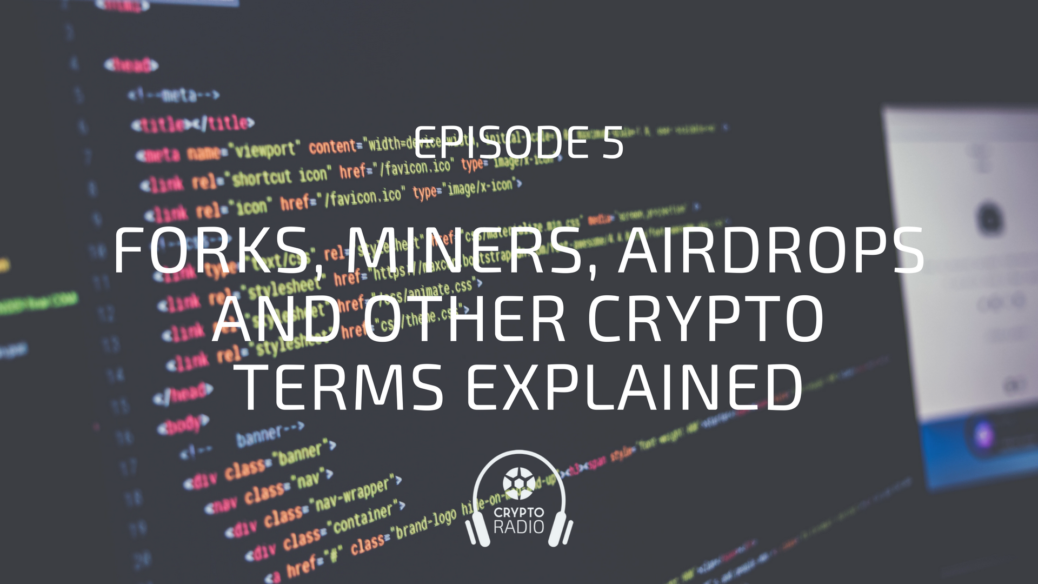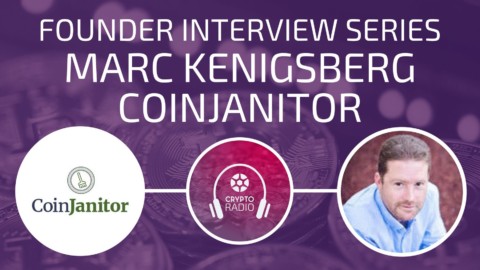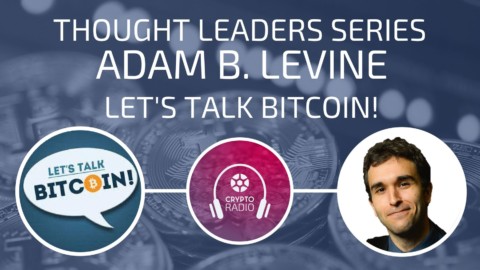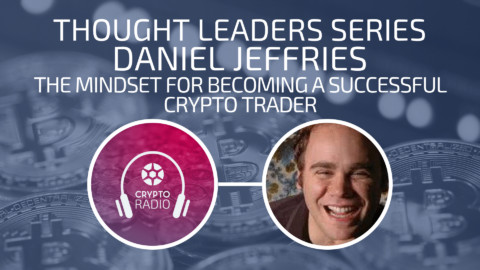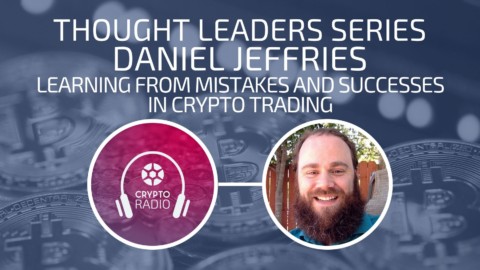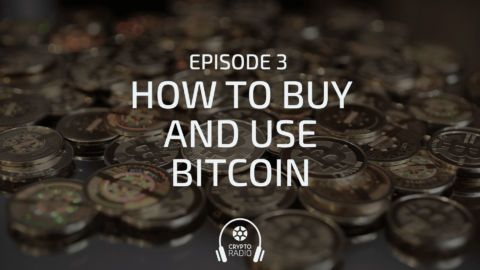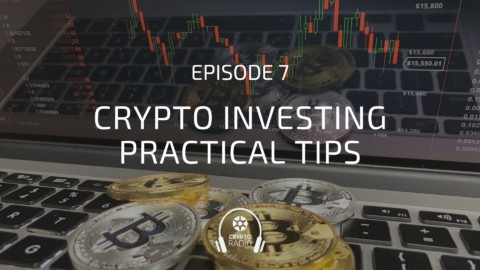Podcast: Play in new window | Download
Mike: Welcome to Crypto Radio. We interview top thinkers and entrepreneurs in the cryptocurrency and blockchain industry. We also cover topics like investing, trading, and ICOs. We’re your hosts, Mike Gilliland, Michael Paul, Chris Sparks and Euvie Ivanova. We’re entrepreneurs, crypto investors, and co-founders of a new blockchain investment platform cosyndicate.io. We created cosyndicate and Crypto Radio to make crypto investing a better experience for you.
In the first episodes of this podcast we’re going to cover the basics [00:00:30] of Bitcoin, blockchains, and crypto investing. If you’re new to the space, these episodes are for you. if not, skip ahead to the episodes where we start to interview founders of blockchain projects and update you on all the news and important events in the crypto world. Over the next few episodes we’re going to be running a contest to give you a chance to win over $3,000 worth of prizes including cosyndicate tokens and a free membership to our private investment mastermind group. To learn how to participate, go to cryptoradio.io.
[00:01:00] So, why don’t we jump back and talk about some of the terms here, because I realize we’re all in the industry and we know what we’re talking about, but the people listening might not know what a dowel and an ICO is. So, why don’t we define that?
Chris: Yup, so an ICO is basically somewhere between a crowdfunding campaign and an initial public offering. For people who don’t know what an initial public offering is, that’s what happens when a company is at a certain level of maturity and then starts issuing shares to the public, or making the ability to buy shares open to the public. [00:01:30] So, you and me can go buy stock in Google, for example. An ICO is kind of jumping several steps ahead of that and going straight to crowdfunding, a project in a very early stage.
So, at a very low-level of maturity you can now essentially get what looks like hundreds of millions of dollars for your project if you have a good enough white paper and idea. If your solution to a problem looks like something that a lot of people want to have solved, then you stand to benefit immensely by doing an ICO. What you do is you put your idea [00:02:00] into the world, you ask that people buy certain tokens that represent either ownership or value in your company, and then basically give out portions of your company in return for dollars or euros in funding.
Michael: Yes, I think it’s important to separate also between utility tokens and security tokens, because that’s the kind of new emerging wave of growth. So, we’ve had a lot of growth and utility tokens, which is like all these apps that are building on the Ethereum blockchain that we talked about. So, they’re all, you know, offering their tokens which is basically access to their platforms [00:02:30] they’re building. So, it represents the right to use their platform essentially. It’s not meant to be an investment, but obviously, you know, as the value of these platforms grow, the price of these tokens will also increase.
So, it’s very much treated as an investment by a lot of people. And that causes a lot of problems with regulation. So, that’s why this whole space is very interesting, because it’s such a new unregulated ecosystem and obviously governments are now looking at it very closely to see how can they kind of regulate it and control it. You know, supposedly to protect people, but ultimately, it’s always a control thing. So, that’s kind of where we are at the moment. And security tokens are more directly like financial instruments, [00:03:00] like of ownership.
So, much like shares in a company, you typically will get like dividend from the profit model, the business model of that company. And that can be distributed via security tokens. So, that’s something we’re actually looking at with cosyndicate and obviously it’s a very new wave of growth. I think that, when there’s going to be more regulation, there will be exchanges that can support that. Right now, exchanges don’t like to list security tokens because it’s so much, you know, problems with the regulation in America and other countries. So, we’re kind of in an in between space where it’s kind of an investment, but it’s not an investment.
Chris: Yeah, yeah. So, they want to regulate it because it’s looking [00:03:30] like a lot of people are actually scamming the public with their ICOs. Does anybody want to talk a little bit about scams? I think Michael, you’re probably the best for this, because you know a lot more about how people can get away with making a token look really nice, but actually it’s, you know, there’s no reason to have something blockchained, there’s no reason to have a token.
Michael: So, that’s a good point. Like what you’re saying, does there need to be a blockchain for this, or does it need to happen on the blockchain? Because a lot of ICOs are just fundraising schemes now that are very popular to kind of jump on, [00:04:00] and companies, you know, that are maybe struggling with their traditional business are saying, “We can do a blockchain version of this app, and we can raise a bunch of money.”
So, that’s also very something you have to be careful about is why is this company raising funds, what’s the purpose of it, where is it going to go. Obviously, the team behind that project, you need to look at that very closely because these are all very early stage start-ups, right? So, this whole space is speculative. It’s like doing any kind of, you know, venture capital investing. You’re investing in the team and the chances of failure are very high.
So, most people probably shouldn’t be doing it, but just the fact that now anyone can do it’s not very regulated, it opens up the door to [00:04:30] a lot of scammers and fraud, people doing fraud. You know, not really raising money for legitimate reasons. So, even if they are legitimate, there’s a high risk of failure. And that’s also good distinction to make is that you’re not guaranteed any kind of return on these investments. They are highly speculative, highly risky, and unless you know what you’re doing, you know, that’s probably not the best place to start with cryptocurrencies in terms of how you can start to get involved.
But it is very exciting because it’s, you know, rumours of the regulations and middle men. I think that’s also why the governments want to control it, because ultimately there’s a lot of money they’re missing out on. All the banks, you know, and all the financial institutions that want to make a bunch of money [00:05:00] from the IPO model, you know, and acting as a broker, they’re losing a lot of business. So, I think there’s going to be a lot of lobbying and screaming to say, “Hey, you know, we need to ban these ICOs because it’s draining a lot of money and wealth away from traditional finance.”
Chris: Yeah, and it’s not like they’re losing a lot of their business. Eventually there’s the possibility of them losing all of their business. If there’s no need for a middle man anymore then clearly the market’s going to decide that it’s no longer necessary.
Michael: Yeah, sorry, that’s what I’m saying about security tokens, right? That it essentially replaces the share market. So, that is the biggest chunk they’re mainly going to use, and obviously they’re seeing that coming, so they’re trying to front run [00:05:30] that, you know, in my opinion.
Chris: Yeah, so one more, just one more thing about ICOs. You said that it’s like any kind of VC funding. It is a lot like VC funding, except for one major point and that is the maturity of the company. And the process through which these start-ups go to get this level of funding. Like, when you talk about VC funding it’s also a process, right? You have to go through several different levels of vetting, so that the venture capitalist knows that they’re putting their money towards something that says what it says it is. And normally, this means [00:06:00] going through an incubator, learning a lot about, you know, the lean process, business model canvas etcetera, all these things. But these companies in the ICO space aren’t doing any of that.
Michael: Well, I think, yeah, there’s definitely a real spectrum now. It’s kind of definitely maturing, I think we are seeing a lot of ICOs we’re investing in now have come from incubators. They do have really good financial backers, you know, like institutional investors, VC funds already. So, if you invest in those kind of ICO projects you probably have reduced risk. So, there definitely is a maturing in the space, but there’s tons and tons of scams and, yeah, [00:06:30] people that shouldn’t be doing business, have no experience, and probably won’t pull it off.
Euvie: Yeah, that’s the second thing actually I wanted to mention. It’s not just the maturity of the project in the ICO space that’s different from the VC model, it’s also the maturity of the investors. Because, you know, in the VC model you have to be an accredited investor, you have to have experience, a lot of the time people are older. They’ve had many decades, you know, in business themselves before they become a VC. In the ICO space, any 18-year-old kid with an internet connection can invest in an ICO. [00:07:00] So, there’s a lot of inexperienced people who come into this, who don’t understand the technology, don’t understand the business model and they just throw money at it because it’s new and exciting and innovative.
Mike: And to clarify, you said any 18-year-old kid, there’s actually no age limit on it, so it can be any age person can get into it.
Chris: Yeah. Sorry, I feel like I have to say this again, to understand sort of like the people that are running these projects, from my understanding it is a lot of like very young idealistic engineer minded kids, right? A lot of these projects are [00:07:30] headed by people like Vitalik, Dan Larimer, I can’t off the top of my head think of anymore at the moment. But basically, they’re first time entrepreneurs, don’t have a huge understanding of marketing or the complexities or running a start-up from an entrepreneurial perspective, but they’ve got, you know, they’ve got the engineering in the bag. Like, they know what they’re doing on an engineering level. But they don’t necessarily know how to make a company successful.
So, that is another risk that you take by investing in these things. And, again, the short and the long end of investment advice is never invest in anything that you’re not willing to lose [00:08:00], and understand that this is like the wild west and you might as well be on a stage coach with like a shotgun on your lap, flying across a desert landscape trying to avoid bank robbers, right? This is where we are at the moment in this space. But it is maturing and that’s exciting. I want to see how it self regulates, rather than someone like the SCC coming in and telling them exactly how to manage this process, but we’ll see what happens. Let’s move on a little bit. There’s a self-regulation mechanism build into [00:08:30] the blockchain called forking. What is a fork?
Euvie: A fork is basically when the community decides that the software of the blockchain is insufficient for the current purpose, and decides to change it to fit better for whatever purpose they’re trying to make it fit for.
Mike: Or, do future updates. Any kind of updates that they want to do to the blockchain, or the code, or the tokens, then they would have to come to a consensus and then all agree, and then publish the new code.
Euvie: Yes. So, at the end, [00:09:00] you basically have two versions of the software, two versions of the coin which have the same history up until the point of the split, and then they each have their own history going forward after that.
Chris: Interesting. So, in the case when the dowel, decentralized autonomous organization, a group of people came together to raise funds for new start-ups, they got hacked, a bunch of money got drained, and then the entire community came together to decide whether to roll back the blockchain before that hack had occurred and give everyone their money back. And that as a really [00:09:30] contentious decision because a lot of people didn’t believe that that hacked money should be returned because it was against the principles of immutable ledgers where it can’t be changed.
Euvie: Some people believe that the whole premise of the dowel was that code is law and by rolling back the blockchain up to a certain point where, like, before the attack happened and saying that, “Actually, all of those transactions don’t count,” was going directly against the whole philosophy of the dowel. But in the end [00:10:00] that’s what they decided to do, because it was more fair to the whole ecosystem.
Michael: The majority of people went with that. So, it’s majority vote, right, that’s how they achieve consensus. And that’s necessary in a system, yeah, like I said, where you don’t have a bank or a central institution, you know, governing that. There needs to be a mechanism for disagreement and, you know resolution.
Mike: Yeah, exactly.
Chris: Okay, so there’s, we’re talking about people making decisions actually and who are the people making decision to run this different software? So, if you need to convince a whole bunch [00:10:30] of people to run a new Ethereum versus the older Ethereum, who are the people that we actually have to convince?
Mike: The miners.
Chris: Right. Okay, so what do the miners actually do?
Michael: So, now when Mike mentioned it’s the miners that decide, basically what the miners are doing, you know, on Bitcoin, for example, on the blockchain is they are processing all the transactions. So, all the records of accounting, you know, what money’s being sent and to whom, that’s all handled by the nodes. So, these miners, these nodes are essentially solving the algorithm, securing the network and transactions and, you know, doing all the processing. [00:11:00] So, they decide which Bitcoin, which blockchain to mine and if there’s a fork or there’s a disagreement they will be the ones that decide which one they thing is more legitimate, which one has more, you know, proper potential for them because ultimately, they’re also speculators, that’s why they’re in the game. You know, they’re not neutral really, they don’t really care, they want to make money. So, proof of work is essentially where the miners get the block rewards for doing that work, and proof of stake is sort of an emerging model for consensus where token holders essentially can act as nodes and you don’t have to reward the miners. So, there’s like hybrid models between the two [00:11:30] but ultimately, those are just the people securing the network and handling the transactions and securing the network.
Chris: Do you know what the energy profile of the, for example, Ethereum network will look like when proof of stake actually comes into play?
Michael: I think there’s different models, there’s no way to really know. But there’s different models that obviously say it won’t be so energy intensive because it won’t be so confrontationally intensive, you won’t have to pay all the miners like you do with proof of work to give them the block rewards. So, proof of stake is just consensus by slightly more energy model.
Chris: [00:12:00] I like thinking of proof of work as a system by which you as a user of Bitcoin are paying back the miners for converting energy that they have to buy, of course, into security by running these algorithms and they’re just basically the people that secure the entire network by running very expensive and application specific machine processors, just like the ones you have in your laptop but a lot more, yeah, a lot bigger and energy consuming. But proof of stake is, again, another way of [00:12:30] distributing sort of that function within the blockchain network amongst the people that are actually using it rather than having the miners who need a lot of energy to basically fulfil their job.
Michael: I think it all comes down to the centralization. So, if the mining is heavily centralized like we’re seeing with Bitcoin and, you know, there’s only certain people that can afford to do it and it’s very specialized hardware, or the money’s going to flow to the top, it’s not very democratic. The decision making and governance, you know, is done by the miners, that doesn’t really benefit necessarily the average user of Bitcoin. So, there’s definitely conflicts of interests there with, you know, [00:13:00] with proof of stake it’s the same thing. If the centralization of the coin is held by a few parties, more obviously collusions much easier, it’s not very decentralized. But if there’s air drops and there’s decentralization built into the model, that can be much more beneficial for all the users of the ecosystem. So, it’s just how you design it and there’s different designs and different intentions in these projects.
Chris: What is an air drop?
Michael: So, an air drop is basically a decision by the team to send a certain amount of tokens to all the community. So, a bunch of people will, you know, get excited by this project, say, “Yeah, I want to get involved,” and the project will allocate a certain number of tokens to airdrop. And they’ll basically [00:13:30] distribute them for free to potentially people who are, you know, early adopters and users and part of the community. And that basically gets them involved, gives someone a piece of ownership and obviously, it’s kind of a marketing tool, as well. Because, you know, people now have the coin, they’ll talk about it with their friends, and tell people about it. So, it’s a way of spreading the word about your project, but also to get sort of early adopters, early users into your community and start using your platform.
Mike: Have you guys experienced airdrops yet?
Euvie: Yes.
Chris: Yeah, it’s cool. So, to the audience, if you have a wallet, basically if you start noticing coins just showing up on your wallet that didn’t really ever hear [00:14:00] of before, that’s an airdrop. It’s a marketing action, so they’re giving you these coins so that you can start using them.
Michael: You can argue it’s also a distribution, decentralization of ownership of the tokens. But it depends how it’s done.
Chris: Definitely, I mean if you talk about marketing from the perspective of, “How do I get my product into the hands of the right customer at the right time?” Then this is pure marketing actually.
Mike: Cool, I think this is a good place to wrap it up. I know we covered a lot of complex topics in this episode. So, what I’m going to do is include a glossary of terms that you can download for this episode, and you can find that at [00:14:30] cryptoradio.io/five. Thanks for listening to Crypto Radio. To get the show notes, links, and other resources from this episode, go to cryptoradio.io/five. To get a chance to win coast tokens and a membership to our private mastermind group for investors, go to cryptoradio.io/contest. And if you liked this episode, don’t forget to leave a review and give us a five-star rating at cryptoradio.io/reviews. Thanks for listening and we’ll see you in the next episode. [00:15:00]
This episode is part 5 of our introductory series to cryptocurrency.
Introduction to cryptocurrency terminology
In this episode we will cover:
- What is an ICO – Initial Coin Offering?
- What are utility tokens and security tokens, and what’s the difference between them?
- What is a fork in a blockchain and why forking happens?
- What is the role of DAOs – Decentralized Automonous Organizations
- Who are miners and what are they doing?
- What is the difference between proof of work and proof of stake?
- What is an airdrop?
Resources:
- Crypto Radio’s Glossary of Crypto Terms
- More in-depth blockchain podcasts & videos from Future Thinkers

